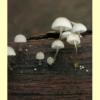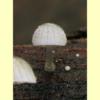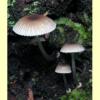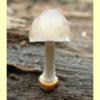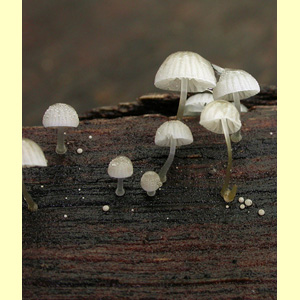
images/Mycena_section_Sacchariferae/Mycena_Sacchariferae_PG_EDSCN9643.jpg
Small agaric, growing on litter or mulch or wood, with a white spore print. Pileus white, pale, orange, brown or grey, dry or moist, viscid or glutinous; surface often pruinose or mealy. Lamellae adnexed, adnate, rarely free or sinuate or notched. Stipe central. Partial veil remnants absent. Spores hyaline, amyloid or rarely non-amyloid, smooth; germ pore absent. Cheilocystidia present. Lamellar trama regular. Pileipellis a cutis, hymeniderm or epithelium; composed of acanthocysts (globose, fusoid, short-cylindrical, sphaeropedunculate or clavate elements with numerous short protuberances, at least on the apex). Clamp connections present.
The pileipellis structure, composed of acanthocysts, separates
Mycena section Sacchariferae from other species of the genus. When the acanthocysts are in the form of a hymeniderm, this arrangement is similar to the pileipellis of
Marasmius, but in this genus the fruit-body is tough, the stipe is often very dark below and paler above, and spores are non-amyloid. Small species of
Coprinellus and
Coprinopsis can have a mealy pileus surface, but the spore print is dark.
Mycena section
Saccharifera Kühner ex Singer,
Sydowia 15: 65 (1962).
Eight species:
Mycena banksiae,
M. carmeliana,
M. fumosa,
M. judithiana,
M. minya,
M. piringa,
M. piterika and
M. tenerrima (only recently recorded from Australia).
Mycena section Sacchariferae is keyed out separately because the pileipellis does not consist of long, cylindrical, nodulose hyphae (as in most other Mycena) but has acanthocysts.
W.A., S.A., Qld, N.S.W., Vic. and Tas. (and probably also N.T.).
In native forests and in pine plantations, and possibly in gardens.
On wood or litter.
Saprotrophic.
Bougher, N.L. (2009a),
Fungi of the Perth region and beyond: a self-managed field book, Western Australian Naturalists' Club (Inc.), Perth. [
Description and
Illustration of
P. praestans]
Bougher, N.L. (2009b), Two intimately co-occuring species of Mycena section Sacchariferae in south-west Australia, Mycotaxon 108: 159–174. [B&W Illustration, Description and Microcharacters of M. judithiana and M. tenerrima]
Breitenbach, J. & Kränzlin, F. (eds) (1991), Fungi of Switzerland. Volume 3. Boletes and Agarics 1st part. Edition Mykologia, Lucerne. [Illustration, Description and Microcharacters of M. adscendens, a European species in section Sacchariferae]
Fuhrer, B. (2005), A Field Guide to Australian Fungi. Bloomings Books, Hawthorn. [Description and Illustration of M. carmeliana, M. fumosa and M. minya]
Grgurinovic, C.A. (1997a), Larger Fungi of South Australia. The Botanic Gardens of Adelaide and State Herbarium and The Flora and Fauna of South Australia Handbooks Committee, Adelaide. [Description and Microcharacters of M. banksiae, M. minya, M. piringa and M. piterika and Illustration of M. piringa]
Grgurinovic, C.A. (2003), The genus Mycena in south-eastern Australia. Fungal Diversity Press, Hong Kong and Australian Biological Resources Study, Canberra. [Description, Illustration, B&W Illustration and Microcharacters for Mycena banksiae, M. carmeliana, M. fumosa, M. minya, M. piringa and M. piterika]

